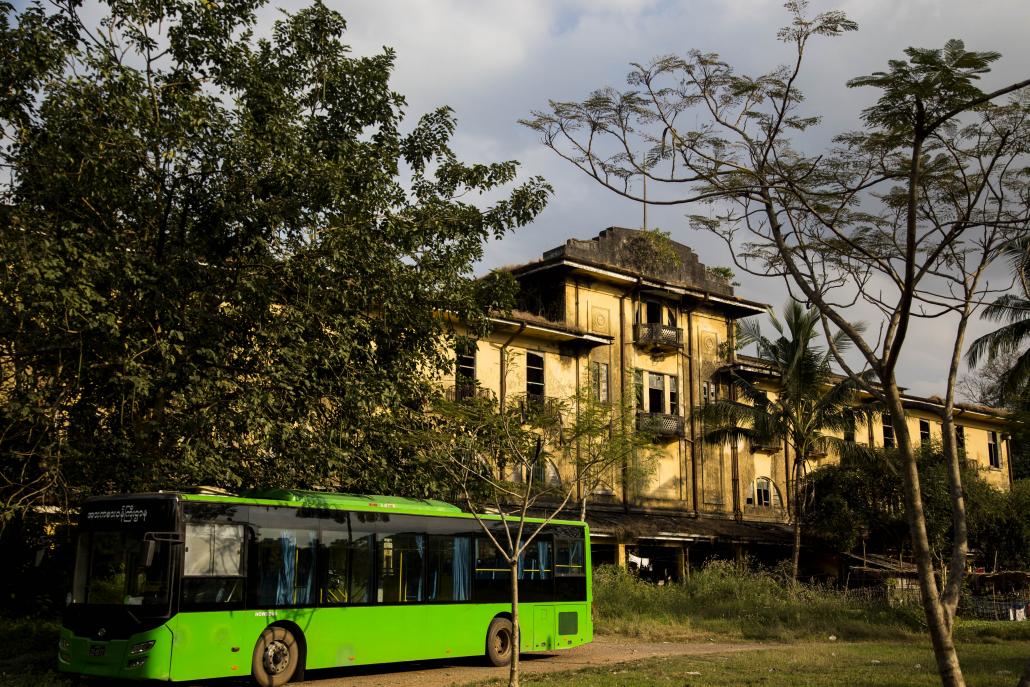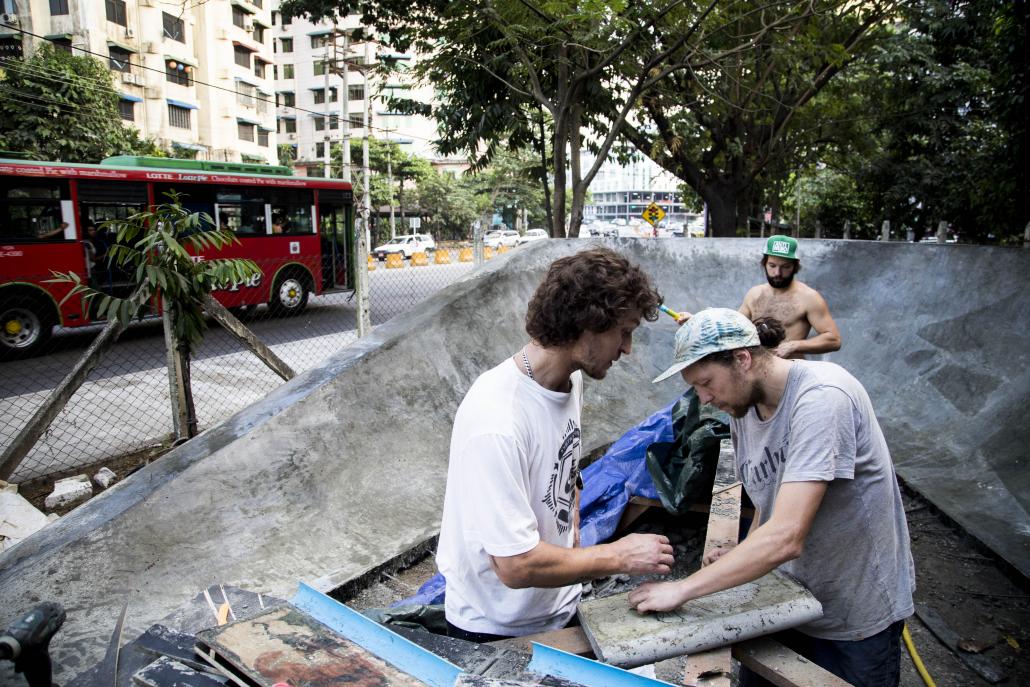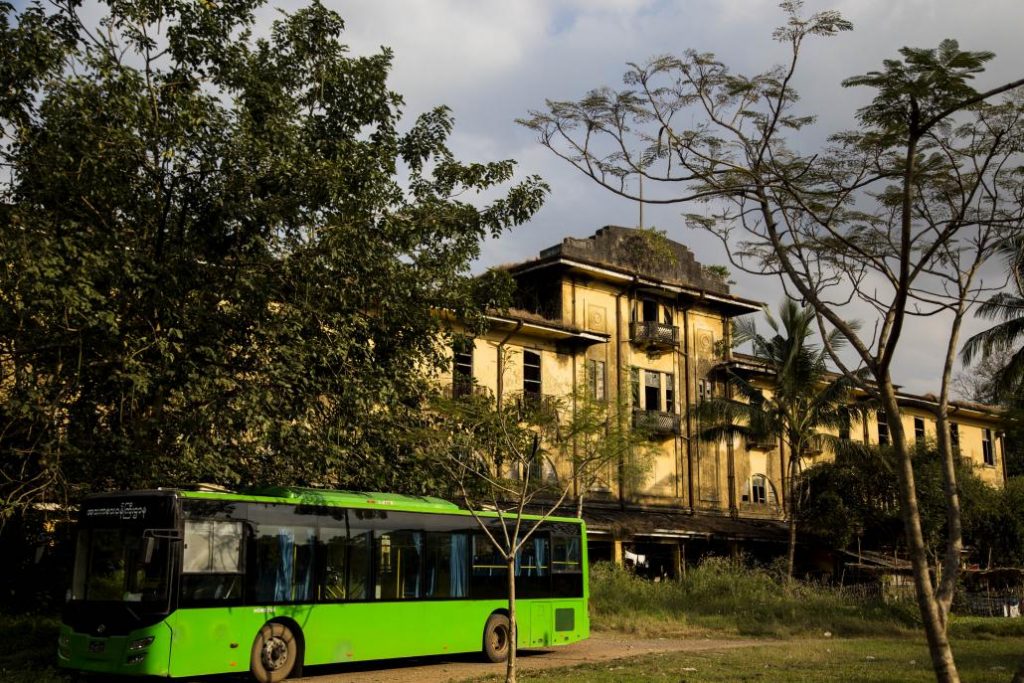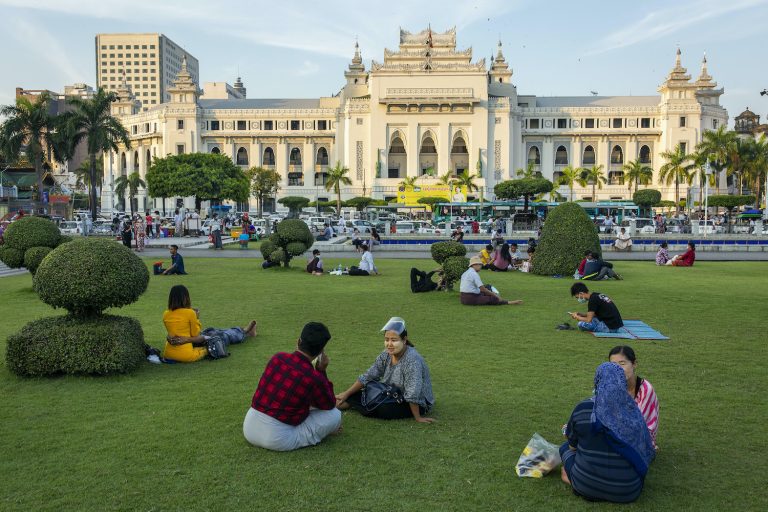Yangon’s already negligible public spaces are under threat from the city’s commercial construction boom.
By OLIVER SLOW | FRONTIER

Scenes from the Institute of Sports and Physical Education in Yankin Township, Yangon. (Ann Wang / Frontier)
It’s a long time since galloping horses thundered around the Kyaikkasan Race Course. The slow race of decay since then has faded the grandeur of the art-deco spectators’ stands. Paint is peeling from the egg yolk-yellow walls and clumps of grass sprout from the roofs.
The dirt track at the former home of the colonial-era Rangoon Turf Club was paved decades ago. Nowadays only elderly matrons, gents with walking sticks and wheezing members of the city’s burgeoning obese class shuffle along the track in the early morning, lapped by the occasional serious jogger.
During the day, teams of students from the Institute of Sports and Physical Education – established at the site in 1996 – compete throughout the vast 147-acre (60-hectare) compound known as the Kyaikkasan Ground in Yangon’s Tarmwe Township. The institute trains boys and girls in football, volleyball, track-and-field, boxing, weightlifting, judo, swimming, badminton, gymnastics and thaing (Myanmar martial arts).
Support more independent journalism like this. Sign up to be a Frontier member.
Real estate developments loom at almost every angle around the periphery of the ground, casting a shadow on this oasis of tranquillity and traffic-free space. There was controversy earlier this year over opaque plans to develop the ground into a “central business district”, but nearby residents believe the proposal has been shelved. Frontier was unable to independently verify the status of the project but there was no indication at the ground that it is threatened by a major re-development.
“We use this space mainly for sport, but we also use it for recreation and to relax,” said ISPE student Ko Phyu Thu Lwin, who was returning to his dormitory room at the ground after athletics training. “This is the biggest and best space for sports in Yangon,” Ko Phyu Thu Lwin said. “There are not many spaces for sport and recreation in the city, so if this was to disappear, I would be really disappointed. There would be nowhere to go,” he said.
Ko Tint Yan Paing, an architect who lives near the ground and uses it daily, agrees.
“This park is a great space for us to get some fresh air, and it also offers a great view of the Shwedagon Pagoda. It is one of the most unique spaces in Yangon and to lose it would be a great shame,” he said.
Yangon City Development Committee manages the commercial capital’s 58 public parks, which cover a total of 470 acres (about 188ha). Yangon has 0.37 square metres of park space for each head of population, among the lowest for a major world city, found a study by U Thant Zaw Oo from the Architecture Department of Yangon Technological University. This is compared to 4.5 sq m for Tokyo, 11.8 sq m for Paris and 26.9 sq m for London, said the study, published in the International Journal for Emerging Technology and Advanced Engineering in May 2014. Throughout the region, other studies have put the figure for Kolkata at 1.8 sq m, Jakarta at 2.3 sq m and Bangkok at 3.3 sq m.
The World Health Organisation recommends that cities provide nine square metres of green space for each inhabitant.
Yangon’s already negligible public space is under growing threat from commercial projects, such as the cluster of restaurant and souvenir shops built in People’s Park opposite the western entrance to the Shwedagon Pagoda.
A Myanmar Times report earlier this year quoted residents of Yankin and Tamwe as saying two parks in their townships were being developed for high-rise car parking. In December last year, prominent activist Ko Ko Gyi was charged over a protest against the seizure of a public park by a private company in South Okkalapa Township.
Yangon Heritage Trust has been vocal in calling for the authorities to make Yangon a liveable city by providing more public spaces. A series of recommendations it issued in October included the development of a network of parks in the city. The include the development of a proposed Dagon Park, just north of the downtown area, as well as a “Yangon University Corridor”, a green belt extending from north of the downtown area to Inya Lake.
“Public spaces are exactly what makes a city a dynamic and exciting place to live, to see, meet and interact with local people,” YHT director U Thant Myint-U told Frontier. “Once people pass a certain threshold in income, happiness often comes from other things, and enjoying life in a beautiful city is one of them,” U Thant Myint-U said. “Wide and clean pavements, parks and other green spaces, accessible waterfronts, areas for recreation and sports, all of these things are vital to people’s health and happiness. Creating and maintaining public spaces should be at the very centre of any urban planning policy for Yangon,” he said.
Ko Win Myo Thu, the managing director of professional development group, EcoDev, said a combination of improper land use planning and corruption have resulted in a dearth of public spaces in Yangon.
“If common places are effectively managed, it will also encourage local small businesses, [to be established] such as eatery shops or other services, in each neighbourhood. Waste control, efficient use of water and energy and cleanliness could also be improved. Sports are important for health care, and with that city life will be more vibrant,” Ko Win Myo Thu said.

Crowd funding paid for a new 300 square metre skate park off Mya Lay Kone Kyaung Rd in Yangon’s Kamaryut Township. (Ann Wang / Frontier)
The campaign for more public space enjoyed a victory earlier this year when the YCDC granted approval to build the city’s first free-of-charge community skate park. The organisation behind the proposal, Pushing Myanmar, worked with the YCDC to establish the skate park on a 350 sq m site on Bayint Naung Road in Kamaryut Township.
A crowdfunding campaign raised the targeted US$21,000 for the project and about 30 volunteer skateboarders from throughout the world arrived in Yangon last month to work with Myanmar builders to prepare the site for its launch on December 5.
“The options for skateboarders in this city are very limited,” said teenaged skateboarder Ko Chan at the Bayint Naung Road site. “At the moment, we have the site under the bridge at Hledan, but this is much bigger. Once it is open we will have more options. It will be great,” he said, a smile lighting up his face.
Ali Drummond, who has been a key figure behind the establishment of the skate park, said he has hoped for a free-to-use skatepark to be established in Yangon since 2009.
Working with international NGO Make Life Skate Life to build the park will benefit Myanmar skateboarders, he said.
“The current Myanmar skateboarders can learn many techniques about skatepark construction, so by the time a new skatepark is built, they will be able to do it themselves without having to rely on a third party,” Mr Drummond said. He said he hopes to replicate the success the project has had in Yangon in Mandalay in the future.
Mr Albert Hatchwell, one of the 30 volunteers helping to build the skate park, predicted that it would help to bring communities closer together.
“I remember when I started skateboarding in Copenhagen in the 1980s, we were just a dozen or so kids. We were outcasts. But once we had a public space, that brought people closer together and got more people involved in skateboarding,” he said.
Mr Hatchwell, who owns a skateboarding company in his native Denmark, has been involved in building skate parks in Bolivia, India and Japan. In the New Year, he will travel to Addis Ababa to build the first public skate park in Ethiopia.
“When these types of spaces are built, it acts as a great space for bringing people together from all walks of life; rich, poor, black, white, whatever,” said Mr Hatchwell. “The skateboard brings this closeness, no matter where people are from,” he said.
As a Belgian skateboarder known as Ratman broke up the pavement with a sledgehammer, Mr Hatchwell pointed to a seemingly cheerful Myanmar man looking on as the international team worked to meet its deadline.
“When we arrived here, this guy who lives overlooking the park, was against it,” Mr Hatchwell said. “But since then he’s really got into the spirit of things and comes down every day to watch progress. This sort of space is great for community spirit,” he said.




